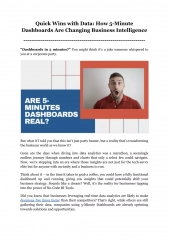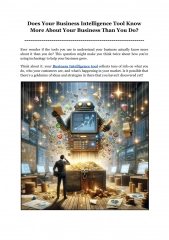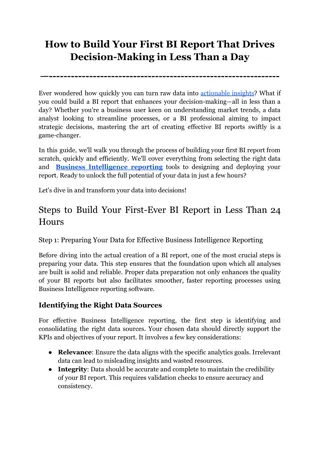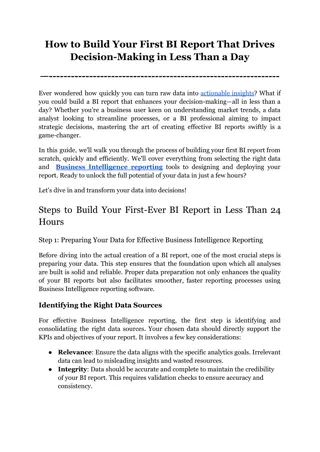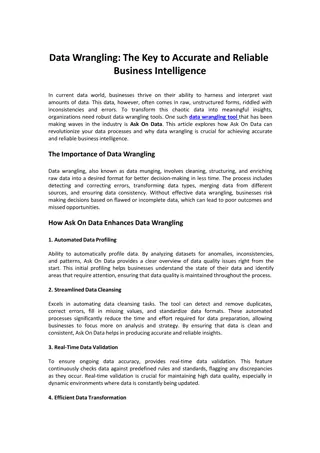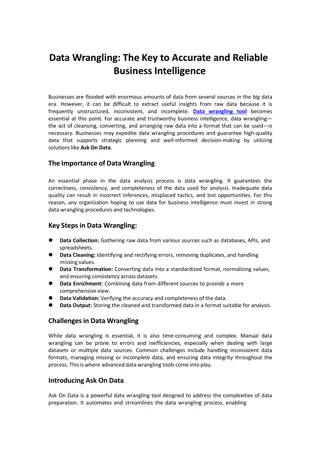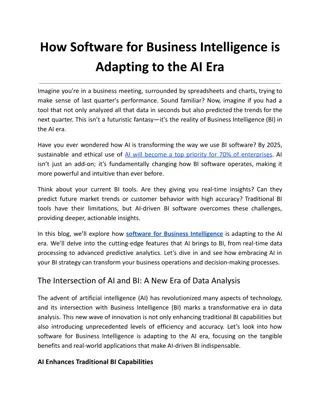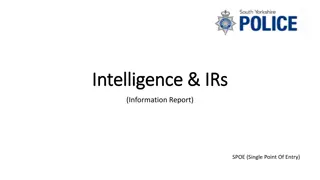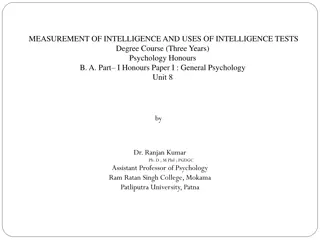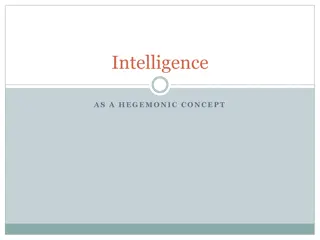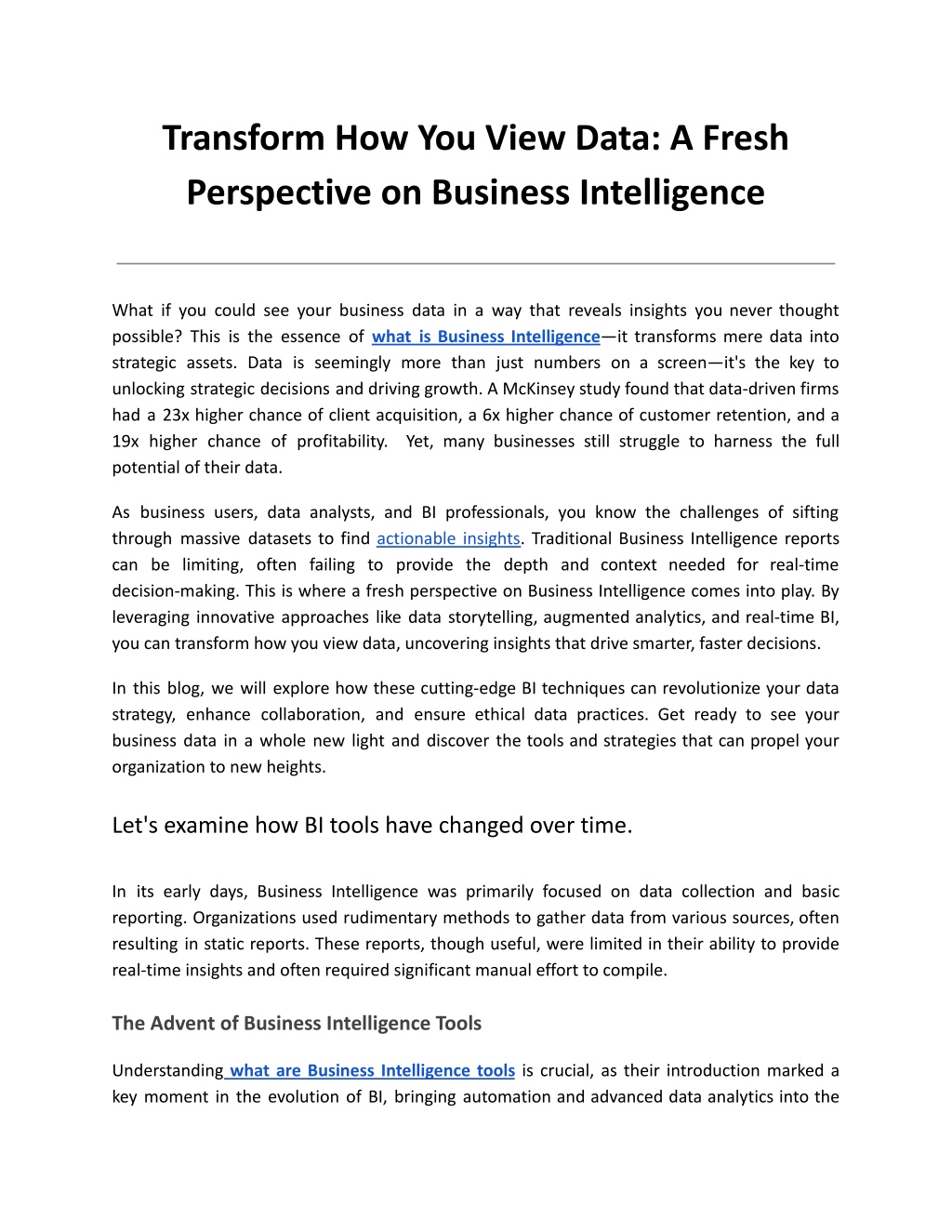
Transform How You View Data_ A Fresh Perspective on Business Intelligence
Imagine unlocking insights from your business data that you never thought possible. What if you could transform raw numbers into compelling narratives that drive smarter decisions? And, what if we say thatu2019s what is Business Intelligence, but al
Download Presentation

Please find below an Image/Link to download the presentation.
The content on the website is provided AS IS for your information and personal use only. It may not be sold, licensed, or shared on other websites without obtaining consent from the author. Download presentation by click this link. If you encounter any issues during the download, it is possible that the publisher has removed the file from their server.
E N D
Presentation Transcript
Transform How You View Data: A Fresh Perspective on Business Intelligence What if you could see your business data in a way that reveals insights you never thought possible? This is the essence of what is Business Intelligence it transforms mere data into strategic assets. Data is seemingly more than just numbers on a screen it's the key to unlocking strategic decisions and driving growth. A McKinsey study found that data-driven firms had a 23x higher chance of client acquisition, a 6x higher chance of customer retention, and a 19x higher chance of profitability. Yet, many businesses still struggle to harness the full potential of their data. As business users, data analysts, and BI professionals, you know the challenges of sifting through massive datasets to find actionable insights. Traditional Business Intelligence reports can be limiting, often failing to provide the depth and context needed for real-time decision-making. This is where a fresh perspective on Business Intelligence comes into play. By leveraging innovative approaches like data storytelling, augmented analytics, and real-time BI, you can transform how you view data, uncovering insights that drive smarter, faster decisions. In this blog, we will explore how these cutting-edge BI techniques can revolutionize your data strategy, enhance collaboration, and ensure ethical data practices. Get ready to see your business data in a whole new light and discover the tools and strategies that can propel your organization to new heights. Let's examine how BI tools have changed over time. In its early days, Business Intelligence was primarily focused on data collection and basic reporting. Organizations used rudimentary methods to gather data from various sources, often resulting in static reports. These reports, though useful, were limited in their ability to provide real-time insights and often required significant manual effort to compile. The Advent of Business Intelligence Tools Understanding what are Business Intelligence tools is crucial, as their introduction marked a key moment in the evolution of BI, bringing automation and advanced data analytics into the
fold. These tools automated the data collection process and introduced new ways to visualize and analyze data. Early BI tools like OLAP (Online Analytical Processing) cubes allowed users to slice and dice data, making it easier to explore different dimensions and identify trends. Today, Business Intelligence reporting tools have advanced significantly. Modern BI tools offer real-time data processing, interactive dashboards, and advanced analytics capabilities. These tools enable organizations to create dynamic Business Intelligence reports that provide actionable insights at a glance. Key features of these tools include the ability to integrate data from multiple sources, offering a comprehensive view of business operations, and utilizing predictive and prescriptive analytics for forecasting and decision-making. Additionally, user-friendly, customizable dashboards allow for easy interaction with data, presenting complex information in an understandable and visually appealing manner. Data Storytelling Beyond Numbers When it comes to BI, raw data can often be overwhelming and difficult to interpret. This is where data storytelling becomes relevant. Data storytelling involves transforming raw data into compelling narratives that not only present the facts but also engage the audience by weaving the data into a cohesive story. This approach goes beyond mere presentation of numbers; it contextualizes the data, making it more relatable and easier to understand. By converting data into stories, businesses can enhance understanding and engagement among stakeholders. A compelling story can draw attention to the importance of the data, show underlying patterns, and impart important lessons. For instance, instead of simply showing a chart of quarterly sales figures, a data story might illustrate how specific marketing campaigns led to spikes in sales, linking actions to outcomes. This method makes the data more meaningful and actionable, helping decision-makers grasp a more fuller picture. Creating an effective data story involves several techniques that transform raw data into an engaging narrative. Using metaphors and analogies simplifies complex data concepts, making them more relatable. Developing scenarios and personas contextualizes data within real-world settings, demonstrating practical applications. Users can study data dynamically and gain insights through interaction using interactive visual components like heatmaps and dynamic dashboards. Ensuring a clear narrative flow with a beginning, middle, and end helps structure the story, while emotional engagement through human elements like customer testimonials creates a deeper connection with the audience. Together, these techniques make data more meaningful, actionable, and memorable. Augmented Analytics The Next Level of BI
Augmented analytics represents a significant advancement in the field of Business Intelligence (BI), leveraging artificial intelligence (AI) and machine learning (ML) to enhance data analysis processes. Traditional BI methods often rely on manual data preparation and analysis, which can be time-consuming and prone to human error. But augmented analytics streamlines and automates these processes, so consumers can get richer and more in-depth insights faster. By integrating AI and ML, augmented analytics not only processes vast amounts of data swiftly but also uncovers hidden patterns, predicts future trends, and provides prescriptive actions. This next level of Business Intelligence reporting tools transform raw data into actionable insights, empowering businesses to make more informed decisions. AI and Machine Learning Integration The integration of AI and machine learning in augmented analytics revolutionizes the way data is analyzed. These technologies automatically generate insights from data without human intervention, significantly reducing the time and effort required for data analysis. AI algorithms can process large datasets quickly, identifying patterns and correlations that might be missed by traditional methods. Machine learning models continuously learn from new data, improving their accuracy and predictive capabilities over time. For instance, AI can analyze customer data to identify purchasing patterns, predict future buying behavior, and suggest personalized marketing strategies. Machine learning can detect anomalies in financial data, flagging potential fraud in real-time. The increasing dependence on AI and ML in business intelligence is demonstrated by Gartner's prediction that 40% of data science tasks will be automated by 2022. The benefits of augmented analytics are manifold, making it an invaluable tool for businesses seeking to enhance their BI capabilities. Finding previously unseen patterns in data is a major perk. Traditional Business Intelligence reporting tools might present raw data in tables and charts, but augmented analytics goes a step further by revealing insights that are not immediately apparent. For example, an AI-driven analysis might show that a particular product sells better during specific weather conditions, a pattern that could be overlooked without advanced analytics. Predicting future trends is another significant benefit. By analyzing historical data and identifying trends, augmented analytics can forecast future outcomes, helping businesses prepare for market changes. This predictive capability is particularly valuable in industries like retail, where understanding future demand can inform inventory management and marketing strategies. A study by Forrester found that companies using predictive analytics are 2.9 times more likely to report revenue growth above the industry average.
Moreover, recommendations based on data insights. For instance, if a BI report shows declining sales in a particular region, augmented analytics can suggest targeted marketing campaigns or augmented analytics provides prescriptive actions, offering specific
adjustments in product offerings to address the issue. This proactive approach enables businesses to respond swiftly and effectively to emerging challenges. Augmented analytics also enhances the accessibility of Business Intelligence reporting tools. With natural language processing (NLP), users can interact with data using simple language queries. This democratizes data analysis, allowing business users without technical expertise to generate insights and make data-driven decisions. "What were the sales trends for the last quarter?" is one question a sales manager might ask. and get an in-depth analysis without wasting time with complicated business intelligence interfaces. Collaborative BI Breaking Down Silos In many organizations, data is often siloed within different departments, leading to isolated data analysis and fragmented insights. This lack of collaboration can result in several drawbacks. Firstly, it hinders the ability to gain a holistic view of the business, as each department only sees a partial picture. For example, the sales team may have detailed information about customer purchases, while the marketing team has data on campaign performance, but without collaboration, the insights from these datasets remain disconnected. This isolation can lead to inefficient decision-making, as critical connections between different data sources are missed. Secondly, isolated data analysis can create redundancy and inconsistency. Different departments may generate their own Business Intelligence reports using varied methodologies, leading to discrepancies and conflicting conclusions. This can cause confusion and erode trust in the data. Moreover, the lack of a unified data strategy can result in duplicated efforts, where multiple teams independently perform similar analyses without sharing their findings. Collaborative Platforms To address these challenges, modern Business Intelligence tools have evolved to facilitate cross-departmental collaboration and data sharing. Collaborative BI platforms enable teams to work together seamlessly, breaking down silos and fostering a culture of data-driven decision-making. One such example is Grow, a BI tool designed to promote collaboration by providing a centralized platform for data integration, analysis, and reporting. Grow allows users to combine data from various sources, creating a single source of truth accessible to all departments. This integration ensures that everyone in the organization is working with the same data, reducing inconsistencies and promoting a unified approach to data analysis.
Collaborative features in Business Intelligence reporting tools include shared dashboards, real-time data updates, and collaborative workspaces. Shared dashboards enable multiple users to view and interact with the same data visualizations, fostering transparency and alignment across teams. Real-time data updates ensure that everyone has access to the most current information, enabling timely and informed decision-making. Collaborative workspaces allow teams to annotate reports, discuss insights, and collaborate on data analysis projects within the BI platform. For example, using Grow's collaborative capabilities, a sales team can share their customer insights with the marketing department, who can then tailor their campaigns based on this data. Similarly, the finance team can provide budget reports that help both sales and marketing teams align their strategies with financial constraints and goals. Real-Time BI Acting on Data Instantly The ability to act on data instantly can make the difference between seizing an opportunity and missing it entirely. Real-time Business Intelligence provides businesses with the most current information, enabling them to respond swiftly to changing market conditions, customer behaviors, and operational challenges. With traditional Business Intelligence reports, businesses often rely on historical data, which can lead to delayed reactions and outdated insights. In contrast, real-time BI ensures that decision-makers are equipped with up-to-date information, allowing for more proactive and agile responses. For example, in the retail sector, real-time data on inventory levels and sales trends can help manage stock more effectively, reducing the risk of overstocking or stockouts. According to a study by Aberdeen Group, organizations that use real-time BI are three times more likely to make timely decisions than those that rely on periodic reporting. Technologies Enabling Real-Time BI Several advanced technologies enable real-time BI, including in-memory computing and stream processing. These technologies are pivotal in processing and analyzing large volumes of data swiftly and efficiently. In-Memory Computing: This technology stores data in the main memory (RAM) rather than on traditional disk storage. Data retrieval and processing become substantially faster as a result of this. In-memory computing can handle complex analytical queries in seconds, providing real-time insights that are essential for quick decision-making. Companies using in-memory computing can analyze vast datasets without the latency associated with disk-based storage, making it ideal for applications requiring real-time analysis.
Stream Processing: Stream processing involves the continuous processing of data streams as they arrive, rather than storing the data and processing it later. This technology is crucial for real-time analytics, as it allows businesses to analyze and act on data as it flows through their systems. Financial services, for instance, can employ stream processing to spot fraudulent transactions as they happen, thereby avoiding losses. Ethical and Responsible BI With the era of big data heading towards continuous waves of rise, the importance of data privacy and ethics cannot be overstated. As businesses increasingly rely on data to drive decision-making, concerns around the ethical use of data and the protection of personal information have come to the forefront. Business Intelligence systems, which collect, store, and analyze vast amounts of data, must navigate these concerns carefully to maintain public trust and comply with regulatory standards. Data privacy involves ensuring that personal information is collected, processed, and stored in a manner that protects the individual's rights. Ethical considerations extend beyond compliance with legal requirements; they encompass the responsible use of data in ways that respect individuals' privacy and autonomy. Misuse of data, whether intentional or accidental, can lead to severe consequences, including legal penalties, reputational damage, and loss of customer trust. For instance, according to a report by the Ponemon Institute, the average cost of a data breach in 2020 was $3.86 million. The financial impact of failing to protect data privacy adequately is sometimes even greater than this. Moreover, with regulations such as the General Data Protection Regulation (GDPR) in the EU and the California Consumer Privacy Act (CCPA) in the US, companies face stringent requirements on how they handle personal data. Serious penalties and interruptions to operations may follow from failure to comply. Conclusion Grow's advanced BI solutions are designed to help you navigate this transformation seamlessly. With our tools, you can integrate and analyze data in real-time, create compelling data stories, foster collaboration across departments, and ensure ethical use of data. Experience the power of Grow s BI platform and see how it can revolutionize your data strategy. Exploring "Grow reviews 2024" to see how our solutions have helped other businesses achieve their BI goals is easier said than done. Ready to transform your data view?
Start your journey towards smarter, data-driven decision-making today with Grow. Sign up for the 14-day free demo and take the first step in revolutionizing how you view and utilize data. Original Source: https://bit.ly/4cZEm8t




